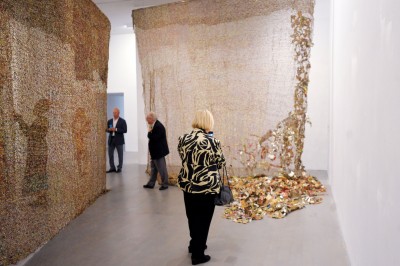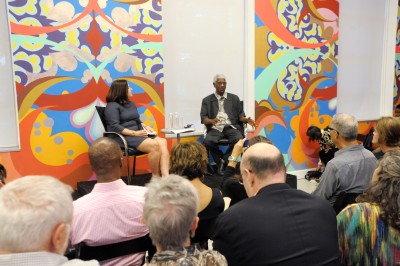
El Anatsui: Shaping our new tapestries
The artist El Anatsui has come a long way. In his lifetime he has crossed continents and cultures, genres in art-making, decades that defined the contemporary world since World War II, and has ended up on the successful end of an important artistic and historical journey. One recent stop on that eventful path was Miami. The native Ghanaian stopped in to open his solo exhibit at the Bass Museum of Art, “Gravity and Grace: Monumental Works by El Anatsui,” the first U.S. survey show of his works now touring the country .It is made possible from a Knight Foundation grant.
Looking calm and casual as he took his seat to chat with Bass Executive Director and Chief Curator Silvia Karman Cubiña, his art talk to a packed room last Thursday could have itself been titled: “Of Gravitas and Grace.” He talked about his history, his influences, the meaning to some of his works in both personal and socio-political terms. He spoke without a hammer of explanation points and with reflection on the fluid nature of this journey.
But to back up, it’s necessary to have some background before discussing this particular show. Born in 1944 into an African continent starting to free itself from colonialism, Anatsui spent his formative educational years during the tumultuous 1960s. He became immersed in an academic world that was based on a British system yet at the same time rediscovering African art and craft traditions. In the 1970s, Anatsui moved to Nigeria to teach art, and to continue to make his own, often from wood and incorporating both African and European aesthetics. (He retired from teaching in 2010).
But it wasn’t really until the 2000’s that the rest of the world grabbed on to Anatsui’s art, especially after his showing at the Venice Biennale in 2007. Anatsui is quoted as saying that 20 years ago, he was known as an “African artist.” Today, he is just an artist.
That’s an important component when viewing his art — which is spectacularly displayed now at the Bass. Many of these pieces are indeed “monumental,” taking over entire walls and corners and looking like magnificent tapestries. But they are made from found refuse, most famously from liquor bottles caps. These flattened metal pieces are painstakingly tied and chained together to form huge, undulating wall hangings. They can resemble African kente cloth, or fishing nets. Anatsui has also used old newspaper and reclaimed wood.
Silvia Karman Cubina with Anatsui
While Africa has long been known as the first world’s dumping grounds, Anatsui pointed out that ecological disasters are of a global order now, no longer exclusive to the developing world. Mass materialism and consumption are no longer exclusive to the West, either. The junk we discard winds up in everyone’s backyard.
During his talk, he also said that lines can be blurred in many ways. While patching together his metal tapestries he may be referencing how Africa was cut up and willy nilly pieced together during colonial rule, but “erosion of cultures is universal.”
And as for the works themselves, painting, sculpture or installation? Likely something again in the middle. Director Cubiña commented that one of her favorite aspects of the exhibit was that the museum had some freedom in hanging the works, so that while the show travelled, it looked different than in the previous museums. Anatsui responded that just like draping any cloth, or placing a sculpture in a room, perception will change. His work “shifts, it can be reshaping all the time.” And he is one of the contemporary art world’s great shape-shifters.
“Gravity and Grace: Monumental Works by El Anatsui” runs through Aug. 10 at the Bass Museum of Art, 2100 Collins Ave., Miami Beach; www.bassmuseum.org.
Recent Content
-
Artsarticle ·
-
Artsarticle ·
-
Artsarticle ·

